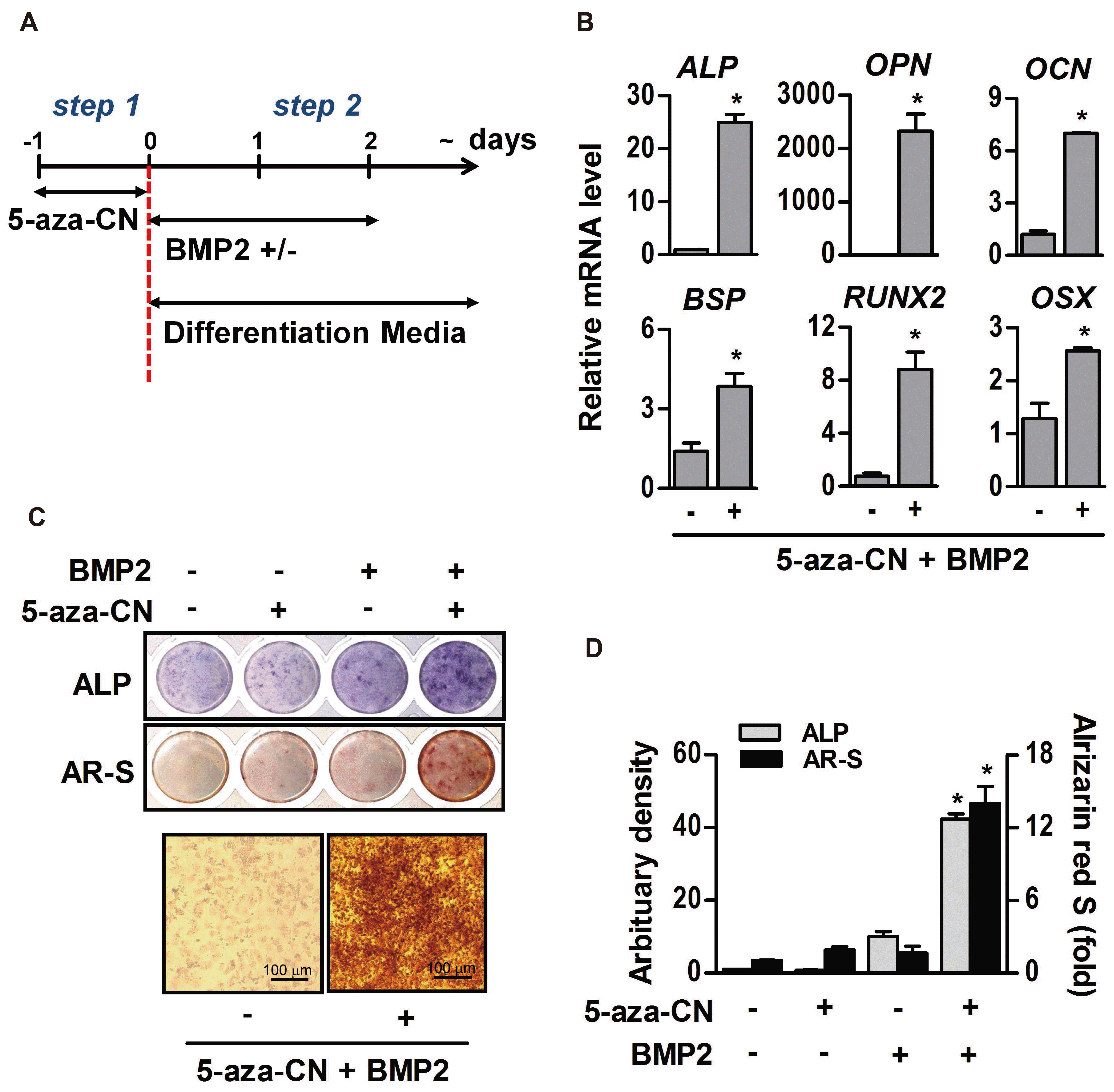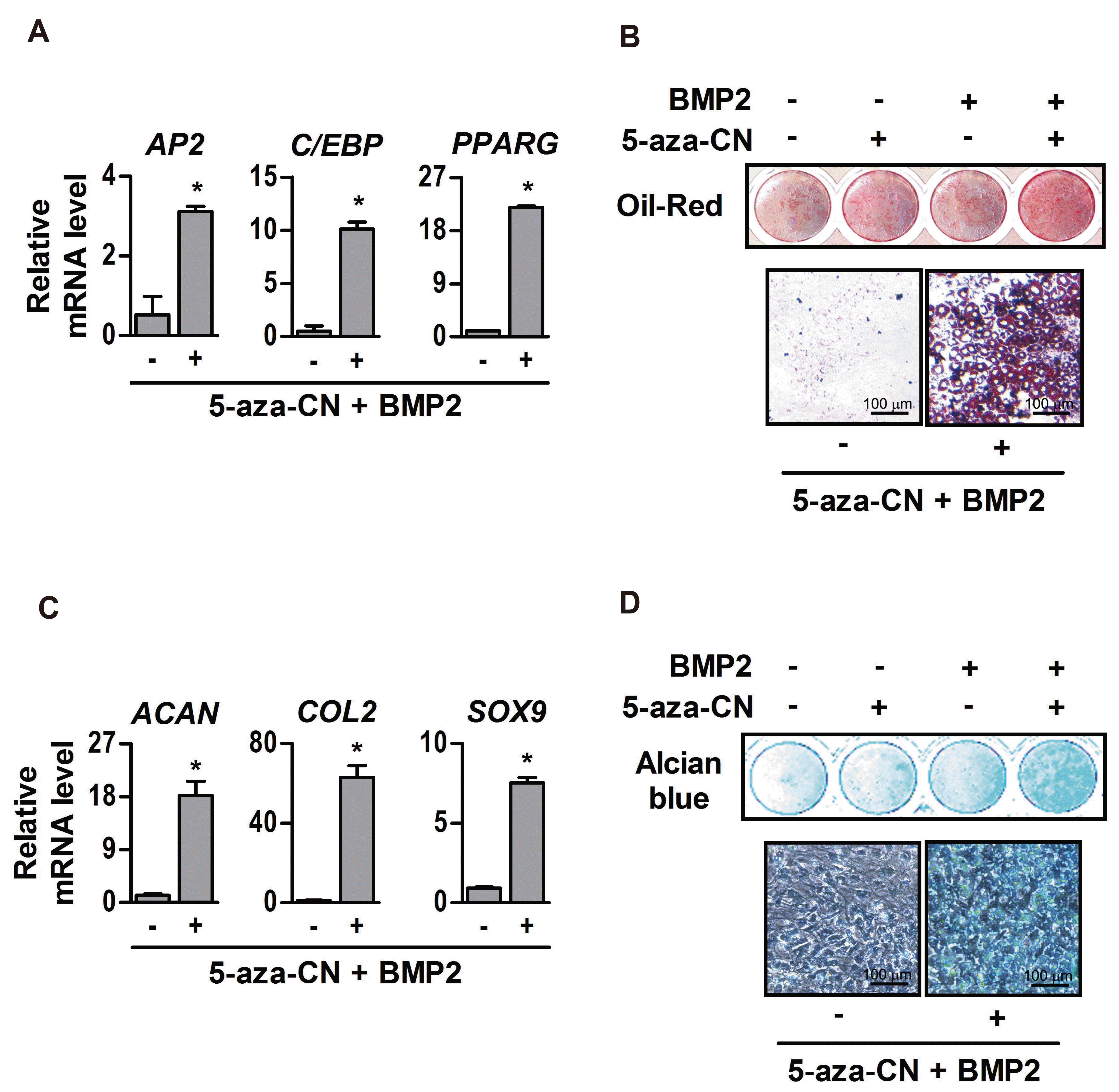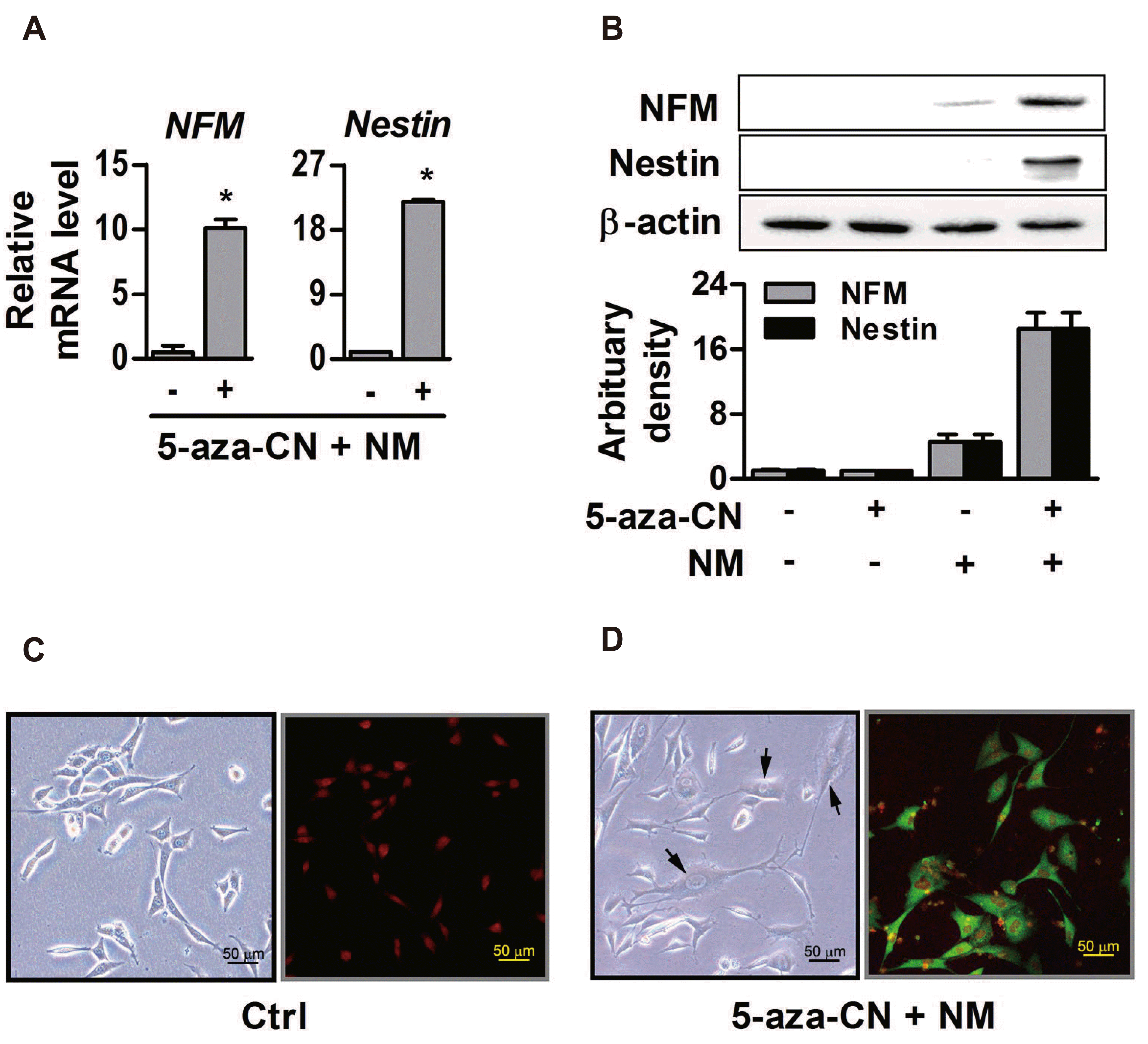INTRODUCTION
METHODS
Cell culture and chemical treatment for epigenetic modification
Quantification of global DNA methylation
Cellular differentiation
Reverse transcriptase-polymerase chain reaction (RT-PCR) and real time quantitative RT-PCR (RT-qPCR)
Table 1
SOX2, sex determining region Y(SRY)-box 2; KLF4, Krüppel-like factor 4; OCT4, octamer-binding transcription factor 4; ALP, alkaline phosphatase; BSP, bone sialoprotein; OCN, osteocalcin; OPN, osteopontin; RUNX2, Runt-related transcription factor 2; OSX, osterix; AP2, adipocyte protein 2; C/EBP, CCAAT-enhancer-binding proteins; PPARG, peroxisome proliferator-activated receptor gamma; ACAN, aggrecan; COL2, type II collagen; SOX9, SRY-box 9; NFM, neurofilament medium.
Western blot analysis
Flow cytometry analysis
Immunofluorescence staining
Cell staining
Statistical analysis
RESULTS
Transient DNA demethylation by 5-aza-CN induced epigenetic modification in NIH-3T3 fibroblasts
 | Fig. 1Epigenetic modification in 5-azacytidine (5-aza-CN)-treated NIH-3T3 cells.(A) After 24 h of 5 μM 5-aza-CN treatment, morphologic changes of cells were observed under an inverted microscope. (a) Untreated; (b) 5-aza-CN-treated; (c) incubated in fresh media without 5-aza-CN for an additional 24 h after treatment with 5-aza-CN. (B) After treatment at the indicated concentrations of 5-aza-CN for 24 h, the global DNA methylation patterns determined by using a methylated DNA quantification kit. (C) The expression of pluripotent stem cell markers such as SOX2, KLF4, NANOG and OCT4 genes was examined by conventional (left) and quantitative RT-PCR (RT-qPCR, right) with or without 5 μM 5-aza-CN for 24 h. (D) The protein expression of CD146, mesenchymal stem cell marker and OCT4 was analyzed by flow cytometry with or without 5 μM 5-aza-CN for 24 h, and quantified to a mean fluorescent intensity (MFI) value. Control (Ctrl) means untreated. These data represent three independent experiments. The values shown represent means ± standard errors. SOX2, sex determining region Y(SRY)-box 2; KLF4, Krüppel-like factor 4; OCT4, octamer-binding transcription factor 4. *p < 0.05.
|
Transient DNA demethylation by 5-aza-CN allowed the conversion of NIH-3T3 fibroblasts into mesenchymal lineage cells
 | Fig. 2Osteogenic differentiation of 5-azacytidine (5-aza-CN)-treated NIH-3T3 cells.(A) The schematic diagram of this study is based on direct reprogramming principles. After 7 days culture in osteogenic differentiation medium (DMEM supplemented 2% FBS containing 170 μM AA, 5 mM β-GP and 200 ng/ml BMP2), expression of osteogenic marker genes such as alkaline phosphatase (ALP), osteopontin (OPN), osteocalcin (OCN), bone sialoprotein (BSP), Runt-related transcription factor 2 (RUNX2) and osterix (OSX) in 5 μM 5-aza-CN-treated NIH-3T3 cells was determined by RT-qPCR (B), and osteogenic differentiation of 5-aza-CN-treated NIH-3T3 was verified by ALP and alizarin red S (AR-S) staining on days 7 and 14, respectively (C). High magnification images of AR-S staining are shown in the lower panel. (D) Densities of ALP stain were quantified by Scion Image software. AR-S stain was extracted with 10% cetylpyridinium chloride and quantified by measuring the absorbance at 570 nm using an ELISA reader. These data represent three independent experiments. The values shown represent means ± standard errors. *p < 0.05.
|
 | Fig. 3Adipogenic and chondrogenic differentiation of 5-azacytidine (5-aza-CN)-treated NIH-3T3 cells.(A) After 7 days culture in adipogenic differentiation medium containing DMEM supplemented 2% FBS with 0.5 mM IBMX, 1 μM DEX, 100 μM, 10 μg/ml insulin and 200 ng/ml BMP2, expression of adipogenic marker genes such as adipocyte protein 2 (AP2), CCAAT-enhancer-binding proteins (C/EBP), peroxisome proliferator-activated receptor gamma (PPARG) in 5 μM 5-aza-CN-treated NIH-3T3 cells was quantified by RT-qPCR. (B) The lipid droplet formations were observed by Oil-Red O staining on day 14 and high magnification images of Oil-Red O staining are shown in the lower panel. (C) After 7 days of chondrogenic differentiation medium culture, expression of chondrogenic marker genes such as aggrecan (ACAN), type II collagen (COL2), SRY-box 9 (SOX9) in 5 μM 5-aza-CN-treated NIH-3T3 cells was quantified by RT-qPCR. (D) The chondrogenic matrix formation was observed by Alcian blue staining on day 14 and high magnification images of Alcian blue staining are shown in the lower panel. These data represent three independent experiments. The values shown represent means ± standard errors. *p < 0.05.
|
Transient DNA demethylation by 5-aza-CN allowed the conversion of NIH-3T3 fibroblasts into neuronal cells
 | Fig. 4Neurogenic differentiation of 5-azacytidine (5-aza-CN)-treated NIH-3T3 cells.(A, B) After 5 and 14 days culture in neurogenic differentiation medium (NM) containing DMEM supplemented 2% FBS, 2% dimethyl sulfoxide and 100 μM butylated hydroxyanisole, expressions of neuronal specific intermediated filament genes such as neurofilament medium (NFM) and Nestin in 5 μM 5-aza-CN-treated NIH-3T3 cells were quantified by RT-qPCR and Western blot analysis, respectively. Arbitrary densities of proteins were quantified by Scion Image software, as shown in the graph below. (C) After 14 days of neurogenic differentiation medium culture, morphologic changes in 5 μM 5-aza-CN-treated NIH-3T3 cells were observed under an inverted microscope (arrows), and NFM protein expression was visualized by immunofluorescence staining. Ctrl means untreated. These data represent three independent experiments. The values shown represent means ± standard errors. *p < 0.05.
|




 PDF
PDF Citation
Citation Print
Print


 XML Download
XML Download